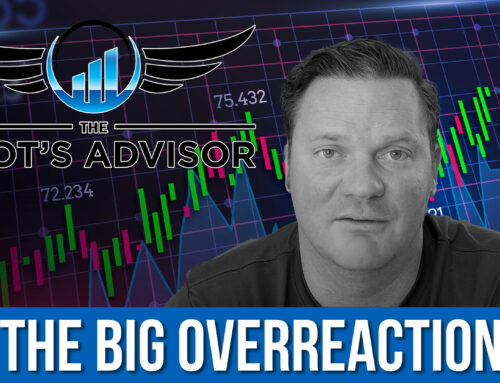STOCKS END Q2 WITH A BANG
After the previous week’s post-Brexit selloff, stocks closed out last week with one of the best performances of 2016 as investors bought the dip. In the first half of the year, the S&P 500 was up 2.69%, the Dow was up 2.90%, the NASDAQ was down 3.29%, and the MSCI EAFE was down 6.28%. All these numbers are as of the quarter’s end on June 30.[1]
What lesson can we draw from recent market gyrations? Markets respond unpredictably to shocks, and periods of strong performance often follow close on the heels of frightening sell-offs. While the media loves to predict gloom and doom at every opportunity, smart investors know to stay calm, look at underlying fundamentals, and stay away from emotional decisions. While we can hope for smooth sailing in the weeks ahead, we should expect continued volatility.
What’s going on with Britain’s exit from the EU?
Within Britain, a lot. In the aftermath of the vote, several major British politicians have resigned, including Prime Minister David Cameron, a key supporter of the “Remain” campaign. The leadership of major “pro-Leave” parties is also in flux, suggesting the coming elections will be eventful.[2]
Several possible roadmaps for the Brexit have been released over the past week by various political factions, but no official plans exist yet.[3] Differences in the way that UK and EU leaders would like to handle the Brexit have also emerged, leading to more uncertainty.[4] We can expect these negotiations to dominate European headlines for months to come.
What does the data say about the U.S. economy?
The focus on international events has overshadowed some positive indicators here in the U.S. The final estimate of Q1 Gross Domestic Product (GDP) growth shows that the economy grew 1.1% in the first three months of the year. This final estimate is up considerably from the 0.5% growth originally reported in the first estimate.[5]
Resilient domestic consumer spending supported growth last quarter and indications suggest the trend continued in the second quarter. Despite a strong U.S. dollar, exports grew more than expected, which is cheering news because it could mean that foreign demand is holding steady.[6]
While we don’t yet have official data on Q2 GDP growth, two advanced forecasts by the Federal Reserve show 2.6% and 2.1% growth, respectively, indicating the economy accelerated after the first quarter.[7]
Earnings reports will emerge in the next few weeks, and analysts are anticipating another tough season with total S&P 500 company earnings expected to be down 6.1% over Q2 2015.[8] Much of the weakness can be attributed to persistent headwinds from low energy prices and a strong dollar. Despite the lackluster growth expectations, we’re hoping to see some positive surprises and standout performances. We’ll know more in a few weeks.
What will the next few weeks bring?
Volatility is likely. Though markets have shrugged off the Brexit panic, Europe isn’t in the rearview mirror yet, and we should be prepared for more hiccups down the road. While the summer is often a sleepy time for markets as traders take their own holidays, recent events make it likely that markets will remain fickle. When trading volume is low, even minor events can have an outsized effect on market performance.
Next week, investors will take stock of last quarter and wait for new data. Friday’s release of the June jobs report will be carefully analyzed to see whether May’s meager job gains were an anomaly or the beginning of a worrisome labor market trend. Minutes from the last Fed Open Market Committee meeting will hopefully provide some clarity about the Fed’s future interest rate decisions.
We’re still closely monitoring markets and reviewing economic data as it emerges. We’ll continue to update you as needed.
ECONOMIC CALENDAR:
Monday: Markets closed for Independence Day Holiday
Tuesday: Factory Orders
Wednesday: International Trade, ISM Non-Manufacturing Index, FOMC Minutes
Thursday: ADP Employment Report, Jobless Claims, EIA Petroleum Status Report
Friday: Employment Situation

Notes: All index returns exclude reinvested dividends, and the 5-year and 10-year returns are annualized. Sources: Yahoo! Finance, S&P Dow Jones Indices, and Treasury.gov. International performance is represented by the MSCI EAFE Index. Corporate bond performance is represented by the SPUSCIG. Past performance is no guarantee of future results. Indices are unmanaged and cannot be invested into directly.
Motor vehicle sales stay strong. Americans continued to buy cars and trucks in June despite the market volatility. Purchases of big-ticket items are a good sign for consumer spending last quarter.[9]
Jobless claims increase. Weekly claims for new unemployment benefits rose by 10,000 last week. Though claims remain at historically low levels, the increase could indicate slowing growth in the labor market.[10]
Construction spending falls. Spending on construction projects fell by 0.8% in May, dropping for the second-straight month. The fall was led by a significant cutback in spending on public construction projects.[11]
Consumer confidence rises. A June reading of how Americans feel about the U.S. economy increased, indicating consumers aren’t letting economic uncertainty get to them.[12]
These are the views of Platinum Advisor Marketing Strategies, LLC, and not necessarily those of the named representative, Broker dealer or Investment Advisor, and should not be construed as investment advice. Neither the named representative nor the named Broker dealer or Investment Advisor gives tax or legal advice. All information is believed to be from reliable sources; however, we make no representation as to its completeness or accuracy. Please consult your financial advisor for further information.
Investing involves risk including the potential loss of principal. No investment strategy can guarantee a profit or protect against loss in periods of declining values.
Diversification does not guarantee profit nor is it guaranteed to protect assets.
The Standard & Poor’s 500 (S&P 500) is an unmanaged group of securities considered to be representative of the stock market in general.
The Dow Jones Industrial Average is a price-weighted average of 30 significant stocks traded on the New York Stock Exchange and the NASDAQ. The DJIA was invented by Charles Dow back in 1896.
The Nasdaq Composite is an index of the common stocks and similar securities listed on the NASDAQ stock market and is considered a broad indicator of the performance of stocks of technology companies and growth companies.
The MSCI EAFE Index was created by Morgan Stanley Capital International (MSCI) that serves as a benchmark of the performance in major international equity markets as represented by 21 major MSCI indexes from Europe, Australia and Southeast Asia.
The Dow Jones Corporate Bond Index is a 96-bond index designed to represent the market performance, on a total-return basis, of investment-grade bonds issued by leading U.S. companies. Bonds are equally weighted by maturity cell, industry sector, and the overall index.
The S&P US Investment Grade Corporate Bond Index contains US- and foreign issued investment grade corporate bonds denominated in US dollars. The SPUSCIG launched on April 9, 2013. All information for an index prior to its launch date is back teased, based on the methodology that was in effect on the launch date. Back-tested performance, which is hypothetical and not actual performance, is subject to inherent limitations because it reflects application of an Index methodology and selection of index constituents in hindsight. No theoretical approach can take into account all of the factors in the markets in general and the impact of decisions that might have been made during the actual operation of an index. Actual returns may differ from, and be lower than, back tested returns.
The S&P/Case-Shiller Home Price Indices are the leading measures of U.S. residential real estate prices, tracking changes in the value of residential real estate. The index is made up of measures of real estate prices in 20 cities and weighted to produce the index.
The 10-year Treasury Note represents debt owed by the United States Treasury to the public. Since the U.S. Government is seen as a risk-free borrower, investors use the 10-year Treasury Note as a benchmark for the long-term bond market.
Google Finance is the source for any reference to the performance of an index between two specific periods.
Opinions expressed are subject to change without notice and are not intended as investment advice or to predict future performance.
Past performance does not guarantee future results.
You cannot invest directly in an index.
Consult your financial professional before making any investment decision.
Fixed income investments are subject to various risks including changes in interest rates, credit quality, inflation risk, market valuations, prepayments, corporate events, tax ramifications and other factors.
By clicking on these links, you will leave our server, as they are located on another server. We have not independently verified the information available through this link. The link is provided to you as a matter of interest. Please click on the links below to leave and proceed to the selected site.
- http://www.usatoday.com/story/money
http://finance.yahoo.com
http://finance.yahoo.com
http://finance.yahoo.com
https://www.msci.com - http://www.theguardian.com/politics
http://www.telegraph.co.uk - http://www.newstatesman.com/politics
- http://www.bbc.com/news
- http://www.bea.gov/newsreleases
- http://www.bea.gov/newsreleases
- https://www.newyorkfed.org/research
https://www.frbatlanta.org/cqer - https://www.zacks.com/commentary
- http://www.foxbusiness.com/markets
- http://www.foxbusiness.com/markets
- http://www.foxbusiness.com/markets
- http://www.foxbusiness.com/markets








